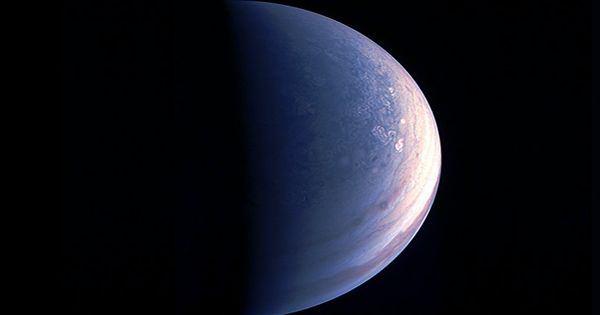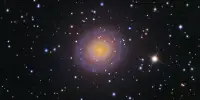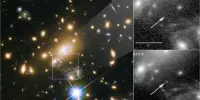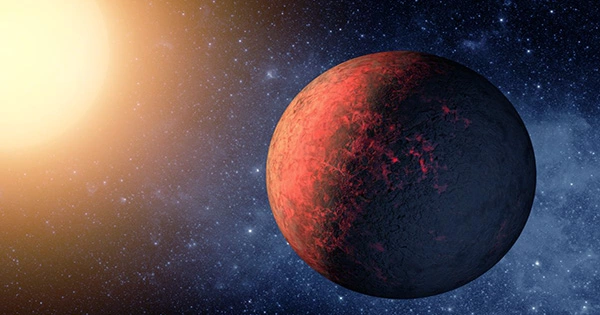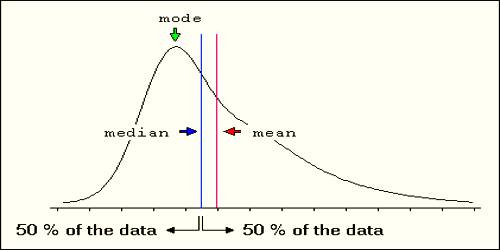Scientists have been attempting to comprehend the composition of Jupiter for millennia. It makes sense given that this enigmatic planet is chemically the Sun’s closest relative and is by far the largest in our solar system. Understanding Jupiter is essential to learning more about the formation of our solar system and potentially other solar systems.
But one critical question has bedeviled astronomers for generations: Is there water deep in Jupiter’s atmosphere, and if so, how much?
Gordon L. Bjoraker, an astrophysicist at NASA’s Goddard Space Flight Center in Greenbelt, Maryland, reported in a recent paper in the Astronomical Journal that he and his team have brought the Jovian research community closer to the answer.
They discovered the chemical traces of water above the planet’s deepest clouds by using ground-based telescopes to observe wavelengths sensitive to thermal radiation escaping from the depths of Jupiter’s persistent storm, the Great Red Spot.
The researchers came to the conclusion that Jupiter has 2 to 9 times more oxygen than the sun based on the pressure of the water and their measurements of carbon monoxide, another gas that contains oxygen. This result confirms predictions made by theoretical and computer-generated simulations that there would be plenty of water (H2O) on Jupiter made of oxygen (O) bound to molecular hydrogen (H2).
Given that the team’s experiment could have easily failed, the revelation was moving. The Great Red Spot is covered in thick clouds, making it difficult for electromagnetic energy to escape and provide information about the chemistry inside.
“It turns out they’re not so thick that they block our ability to see deeply,” said Bjoraker. “That’s been a pleasant surprise.”
New spectroscopic technology and sheer curiosity gave the team a boost in peering deep inside Jupiter, which has an atmosphere thousands of miles deep, Bjoraker said: “We thought, well, let’s just see what’s out there.”
The moons that orbit Jupiter are mostly water ice, so the whole neighborhood has plenty of water. Why wouldn’t the planet which is this huge gravity well, where everything falls into it be water rich, too?
Gordon L. Bjoraker
The information that Bjoraker and his team gathered will be used to enhance the data that NASA’s Juno probe is gathering as it orbits the planet once every 53 days from north to south.
With its own infrared spectrometer and a microwave radiometer that can reach a depth of 100 bars, or 100 times the atmospheric pressure at the surface of the Earth, Juno is among other things searching for water. (Altitude on Jupiter is measured in bars, which represent atmospheric pressure, since the planet does not have a surface, like Earth, from which to measure elevation.)
According to Goddard’s Amy Simon, a planetary atmospheres expert, if Juno returns identical water discoveries, supporting Bjoraker’s ground-based method, it could provide a fresh window into fixing the water problem.
“If it works, then maybe we can apply it elsewhere, like Saturn, Uranus or Neptune, where we don’t have a Juno,” she said.
The most recent mission, Juno, is entrusted with discovering water on this massive gaseous planet, most likely in the form of gas.
In our solar system, water is a large and common molecule. It gave birth to life on Earth and now facilitates a number of its most crucial functions, including weather. It’s crucial to understanding Jupiter’s stormy weather as well as if the planet has a rock and ice core.
As the Sun evolved from an amorphous nebula into the blazing ball of gases we see today, Jupiter is assumed to be the first planet to have formed by siphoning the leftover elements from the birth of our star.
Up until a few decades ago, it was commonly believed that Jupiter had a composition that was identical to the Sun’s: it was an all-gas ball of hydrogen with a little hint of helium. However, there is growing evidence that Jupiter has a core that may be 10 times as massive as Earth.
Prior spacecraft discovered chemical evidence indicating the planet’s atmosphere was created by mixing solar nebula gases with a core of rock and water ice. This idea is further supported by the way Juno feels the pull of Jupiter’s gravity. Even the phenomena of lightning and thunder, which are driven by moisture, exist on the planet.
“The moons that orbit Jupiter are mostly water ice, so the whole neighborhood has plenty of water,” said Bjoraker. “Why wouldn’t the planet which is this huge gravity well, where everything falls into it be water rich, too?”
Planetary scientists have been baffled by the water mystery; essentially every time evidence of H2O appears, something happens to throw them off the trail. The NASA Galileo mission, which released a probe into the atmosphere in 1995 and found it in an exceptionally dry zone, is a favorite illustration among researchers on Jupiter.
“It’s like sending a probe to Earth, landing in the Mojave Desert, and concluding the Earth is dry,” pointed out Bjoraker.
In their search for water, Bjoraker and his team used radiation data collected from the summit of Maunakea in Hawaii in 2017. They relied on the most sensitive infrared telescope on Earth at the W.M. Keck Observatory, and also on a new instrument that can detect a wider range of gases at the NASA Infrared Telescope Facility.
The plan was to determine the heights of Jupiter’s cloud layers by examining the light energy that was emitted through its atmosphere. This would aid scientists in figuring out the temperature and other factors that affect the kinds of gases that can endure in certain areas.
A bottom layer comprised of water ice and liquid water, a middle layer made of ammonia and sulfur, and an upper layer made of ammonia are the three cloud layers that planetary atmosphere researchers anticipate to exist on Jupiter.
Bjoraker’s team examined wavelengths in the infrared spectrum of light, where most gases don’t absorb heat and allow chemical traces to leak out, to validate this through ground-based measurements.
They specifically examined a type of methane gas’s absorption patterns. Methane shouldn’t fluctuate in abundance around the globe since Jupiter is too warm for it to freeze.
“If you see that the strength of methane lines vary from inside to outside of the Great Red Spot, it’s not because there’s more methane here than there,” said Bjoraker, “it’s because there are thicker, deep clouds that are blocking the radiation in the Great Red Spot.”
The three cloud layers were confirmed in the Great Red Spot by Bjoraker’s team, confirming earlier models. The deepest cloud layer is at 5 bars, the team concluded, right where the temperature reaches the freezing point for water, said Bjoraker, “so I say that we very likely found a water cloud.”
The position of the water cloud and the quantity of carbon monoxide the researchers found on Jupiter support the idea that there is a lot of oxygen and consequently water on the planet.
Bjoraker’s technique now needs to be tested on other parts of Jupiter to get a full picture of global water abundance, and his data squared with Juno’s findings.
“Jupiter’s water abundance will tell us a lot about how the giant planet formed, but only if we can figure out how much water there is in the entire planet,” said Steven M. Levin, a Juno project scientist at NASA’s Jet Propulsion Laboratory in Pasadena, Calif.

